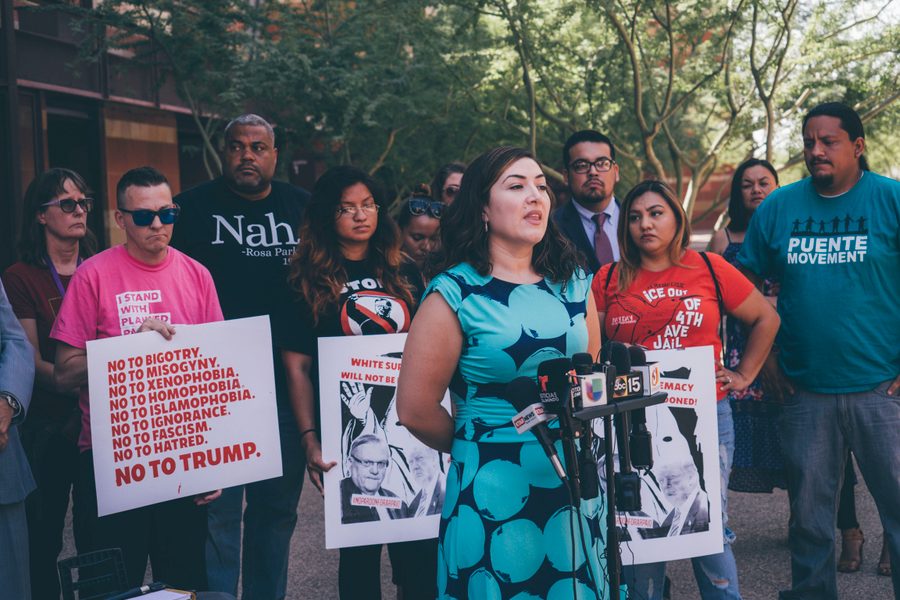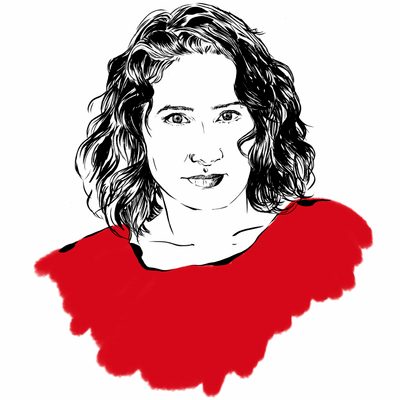The Movement That Ousted Arpaio Is Setting Its Sights State-Wide
A conversation with Alejandra Gomez, the co-director of Living United for Change in Arizona.
Sarah Jaffe

Welcome to Interviews for Resistance. Since election night of 2016, the streets of the United States have rung with resistance. People all over the country have woken up with the conviction that they must do something to fight inequality in all its forms. But many are wondering what it is they can do. In this series, we’ll be talking with experienced organizers, troublemakers, and thinkers who have been doing the hard work of fighting for a long time. They’ll be sharing their insights on what works, what doesn’t, what has changed and what is still the same.
Alejandra Gomez: I am Alejandra Gomez. I am co-director at Living United for Change (LUCHA) in Arizona.
Sarah Jaffe: You were at the rally and counter-rally outside of Trump’s infamous talk last Tuesday night in Phoenix, right? Tell us how it went from where you were.
Alejandra: I will actually start from when we heard about the pardon. We heard that 45 was coming, and we heard very quickly after that he was thinking of pardoning Arpaio. We had a couple of our young leaders with us during the staff meeting, and immediately there were reactions to that, because a lot of those young people worked in the coalition during the Bazta Arpaio campaign to get him out of office.
Through that work, we demonstrated that we no longer wanted a criminal in office. After the election, finally the judges ruled that Arpaio was found in contempt of court. He was defying the judge’s orders to stop profiling and targeting communities of color. Finally Arpaio was deemed a criminal and was taken out of office.
To hear that the president of the United States was going to come and pardon Arpaio reinforced what we already know and what we felt during the campaign trail: This president has been igniting division and hate and emboldening racism, bigotry and white supremacy in his administration.
There was a lot of nervousness going into the Trump rally. One of our young people, when we were huddling before going to the rally, said: “I am scared to go to this rally because of everything I have been seeing, because of what happened in Charlottesville. It feels terrible to be scared of the president of the United States.” That was a very sobering comment.
We said, “Well, we have been doing demonstrations for a really long time and our community is resilient, our community knows how to fight back, and we are going there today because we need to show this administration that we are standing in solidarity and we are against this agenda.”
We went, and it was a wonderful celebration of all of the various communities coming together to demonstrate and push back on this president. It is a very terrible and backwards time when we are having to tell the president to follow the rule of law and listen to the judicial system, because he has gone completely rogue.
We were at the rally and folks were really chanting and celebrating. It was a display of all of the wonderful things that our community has been fighting for, which are equality and justice. Toward the end of the night, police officers were in full riot gear. It was completely unnecessary, because we were peaceful protesters. We built a relationship with the police department. We have had several actions and have shown that we know how to run respectful, strategic demonstrations. The police were out in their full riot gear with the masks, shields, layers of vests on, guns and rubber bullets — and cop cars everywhere.
I think that was more menacing than the Trump supporters. Toward the end of the night, there were still different parts of the community there: There were still women with their children, fathers with their children and family members together. The police deployed tear gas into the middle of the streets, because they wanted to keep the crowd contained. We started to see communities run everywhere. There was no warning.
It was a war zone that was initiated by the Phoenix Police Department. Increasingly, we are seeing this militarization of the police department. We have seen it in other states, and we experienced it here in Arizona where we have marches with thousands of people.
Our state is no stranger to the targeting of our communities for raids. And this was the first time that I had seen such a violent and aggressive display towards peaceful demonstrators.
Sarah: Give us a little background on Arpaio and the things that made him require a pardon in the first place.
Alejandra: Arpaio is the type of person who always wanted to be in the media and was willing to do anything that got him attention. So, Tent City was one of the worst ideas that could possibly happen. It was a complete violation of human rights and prisoners’ rights. What would happen in Tent City was, in Arizona, the temperatures reach about 120 degrees Fahrenheit at any given time in the summer. You have prisoners outside with no air conditioning. There were outhouses for bathrooms. So, all of the feces and urine have stagnated, and you have that smell. You also have everything that is accumulating in terms of bacteria, and all of that among the people who are incarcerated.
On top of that, Arpaio would make it known that he felt people that were in jail should not receive what he would consider food as a luxury. So, he would often give moldy bread and green macaroni to people who were in custody.
Under his jurisdiction, there were smaller cities — these areas where you have largely Native American and Latino populations. In Surprise, Arizona there were a number of reported cases of rape targeting young women and girls, and the sheriff was failing to investigate those rape cases. Millions of dollars were misappropriated.
This was all before SB 1070. Then, the raids started to happen, and Arpaio completely revamped all his vans. Basically, it looked worse than border patrol. They would have signs, “If you see an illegal person, report them.” They had pictures of people. It was a terrible sight to see these vans. Outside of his office, he had a big military tank. Why does a sheriff need a military tank?
Arpaio would go into peoples’ homes, neighborhoods, supermarkets, the flea market, the shopping malls — anywhere where there were communities of color and members of the Latino community in particular. He would go in and conduct raids to do roundups and detain and deport people. This separated countless families in Arizona. During SB 1070, which was the “show me your papers” law, you saw this mass exodus of people moving to other states or going back to Mexico.
So, not only was there a misappropriation of funds, the terrible dehumanization of people who were in jail, and the charges of child rape, but there was also this constant dehumanization and targeting of one community.
Sarah: People have been talking about Trump’s sliding poll numbers and why he would want to pardon Arpaio. I wonder what the reaction has been from your organization and others who spent all this time organizing against Arpaio to this idea that Trump can just pardon him to win points with his base.
Alejandra: Our reaction is that he needs to pardon the victims of Arpaio. We are not shocked that this administration and this president would continue doing the things that he promised on his campaign trail. It was very clear that he had a white supremacist agenda and that he was going to do everything in his power to embolden white supremacy in this country. He is sticking to those promises.
Sarah: Arizona is an interesting state for a lot of reasons. You guys played a pivotal role in the healthcare fight, with John McCain finally casting the deciding vote to not repeal the Affordable Care Act. You are going to have an upcoming messy Senate race, I assume in 2018. Give us a brief rundown of the overall political scene in Arizona right now. What is giving you hope for the future?
Alejandra: Arizona is very much in flux. There are a lot of changes happening. We are in a red state that has been anti-immigrant for years, and no one was paying attention to communities of color and building political power within undocumented communities. As a coalition of organizations, we said: “Well, we are going to do that work ourselves.”
Alongside of the mass mobilization and the powerful marches and displays from the community, there was voter registration drive that started to take place within our neighborhoods. Before, nobody was going and talking to our families about registering to vote and why their voice mattered and why they needed to cast their ballots. So, we started that work in 2010.
That work has continued until today. So, where we saw 4 percent turnout rates in 2010, we saw 22 percent turnout rates this last election. We moved from being Maricopa-centered to working in other counties, like the Pima County area, and thinking state-wide.
In Arizona, there had not been a senate president at the state legislative level that had ever been recalled, and we were told not to do it, because Latinos didn’t have enough power. We were told we weren’t going to be able to recall the senate president that was a co-author on SB 1070, the “Show me your papers” law. But we were able to do it in 2011.
So, with that voter registration, with those demonstrations, with our families learning the importance of showing up in the state capitol and going and demanding justice from their local and federal representatives, we now have a city council that is largely Latino and progressive.
We have a vulnerable seat which is the Martha McSally race. She is somebody who really be careful with how she votes, because her district can easily flip. We are paying attention to that race. Depending on when John McCain continues because of his health, this could be the first time in history where one state has two Senate seats open at the same time. There are a lot of folks who are thinking of those seats right now.
But, Jeff Flake has really turned a corner because of all of that political power that we are starting to build. He understands that he is dealing with an extremist party that is no longer the “good ole boy” Republican politics of the past. This is an extreme white supremacist agenda, and he just released an article where he really called out his party for not having a spine and backbone. That pressure only happened because we have been in his office, doing the voter registrations, telling the stories of the community and really pushing him. He understands that he is vulnerable now.
Arizona passed a minimum wage ballot initiative with paid sick days. In a right-to-work state, that is very powerful. That impacted close to a million people in the same year that we were also able to take out Arpaio. So, this state is definitely changing.
Interviews for Resistance is a project of Sarah Jaffe, with assistance from Laura Feuillebois and support from the Nation Institute. It is also available as a podcast on iTunes. Not to be reprinted without permission.
Sarah Jaffe is a writer and reporter living in New Orleans and on the road. She is the author of Work Won’t Love You Back: How Devotion To Our Jobs Keeps Us Exploited, Exhausted, and Alone; Necessary Trouble: Americans in Revolt, and her latest book is From the Ashes: Grief and Revolution in a World on Fire, all from Bold Type Books. Her journalism covers the politics of power, from the workplace to the streets, and her writing has been published in The Nation, The Washington Post, The Guardian, The New Republic, the New York Review of Books, and many other outlets. She is a columnist at The Progressive and In These Times. She also co-hosts the Belabored podcast, with Michelle Chen, covering today’s labor movement, and Heart Reacts, with Craig Gent, an advice podcast for the collapse of late capitalism. Sarah has been a waitress, a bicycle mechanic, and a social media consultant, cleaned up trash and scooped ice cream and explained Soviet communism to middle schoolers. Journalism pays better than some of these. You can follow her on Twitter @sarahljaffe.








